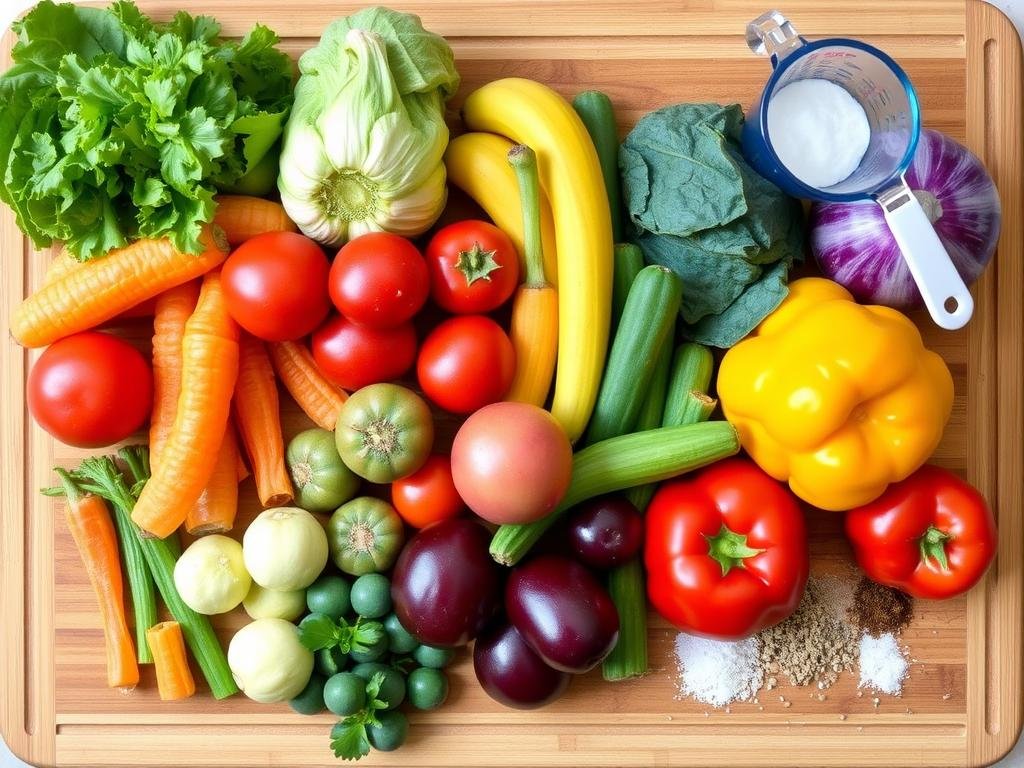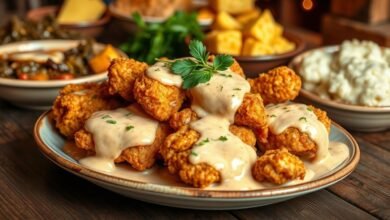Delicious and Healthy Recipes for a Balanced Diet 2024

elFinding time to cook healthy meals can be tough in today’s busy life. But, you can easily make tasty and nutritious food that’s good for you. Are you curious about what a balanced meal is and how to make it part of your daily life?
This guide will show you how to make delicious meals that follow a balanced diet. You’ll learn about the main parts of a healthy plate and get quick, easy recipe ideas. This will help you turn your kitchen into a place of health and flavor.
Key Takeaways
- Discover the essential elements of a balanced meal and why they are important for your overall health.
- Explore the Plate Method, a practical approach to building nutritious and visually appealing dishes.
- Indulge in a variety of delicious and healthy recipe ideas for breakfast, lunch, and dinner.
- Understand the benefits of a balanced diet, including improved energy levels and better digestion.
- Learn tips and tricks for meal planning, preparation, and incorporating variety and moderation into your meals.
What is a Balanced Meal?
Getting the right mix of foods is key to staying healthy. A balanced meal has the right amounts of protein, carbs, and fats. It also includes a variety of vitamins and minerals from fruits, veggies, and whole foods.
Components of a Balanced Meal
A balanced meal should have:
- 50% Vegetables and Fruits – These foods are packed with vitamins, minerals, and fiber. They help your body work its best.
- 25% Lean Protein – Foods like chicken, fish, beans, and lentils are great for building muscle and keeping you full.
- 25% Whole Grains and Fiber – Grains like brown rice, quinoa, and whole wheat bread give you complex carbs, fiber, and B vitamins.
- Healthy Fats – Healthy fats from avocados, nuts, seeds, and olive oil are good for your heart.
Importance of Balanced Nutrition
Eating a diet full of macronutrients and micronutrients is vital. It keeps your energy up, helps with digestion, and supports your health. Following dietary guidelines and eating a variety of nutrient-dense foods makes sure you get a balanced meal. This way, you get the right amount of nutritional intake.
The Plate Method for Balanced Meals
Making nutritious meals easy doesn’t have to be hard. The plate method is a simple way to balance your meals. It helps you get the right mix of vitamins, minerals, and nutrients for good health.
Vegetables and Fruits (50%)
Fill half your plate with a mix of colorful veggies and fruits. This makes sure you get lots of antioxidants, fiber, and nutrients your body needs. Try to use different veggies and fruits to get all the good stuff.
Lean Protein (25%)
Use a quarter of your plate for lean proteins. This could be grilled chicken, fish, tofu, or plant-based options. These proteins give you the amino acids your body needs for repair, immune health, and energy.
Whole Grains and Fiber (25%)
Fill the last quarter with whole grains and fiber-rich carbs. Think brown rice, quinoa, whole wheat bread, or oats. These foods give you long-lasting energy, help with digestion, and keep you feeling full.
Healthy Fats and Oils
Add healthy fats to your plate, like olive oil, nuts, seeds, or avocado. These fats help your body absorb vitamins and keep you feeling full and energized.
The plate method makes it easy to make meals that are good for you. It helps you get the right mix of food groups. This way, you fuel your body and mind right.
Quick and Healthy Meal Ideas
Finding time to cook a healthy meal can be tough today. But, with some quick and healthy meal ideas, you can make tasty, nutritious dishes in 30 minutes or less. These recipes are great for busy weeknights or meal prep. They let you eat well without losing flavor or ease.
Salmon Pasta with Vegetables is one of our top picks. It mixes tender salmon, whole-wheat pasta, and fresh veggies for a meal full of nutrients in 25 minutes. Another favorite is Tofu Poke Bowls. They have marinated tofu, crisp veggies, and tasty toppings for a meal that’s filling and full of flavor.
For a quick breakfast or lunch, try Pesto Eggs. This recipe adds homemade pesto to scrambled eggs, making a meal that’s both protein-rich and delicious. If you’re in the mood for something savory, a Veggie Stir-Fry with lean protein and whole grains is a great choice. It’s ready in just 30 minutes.
Other great meal ideas include Gnocchi with White Beans and Spinach, Tuna and Rocket Spaghetti, and Chicken Burrito Bowls. These recipes use whole ingredients and simple cooking to make tasty, nutritious meals. They’re perfect for busy nights or meal prep.
“Healthy eating doesn’t have to be complicated or time-consuming. These quick and healthy meal ideas prove that you can enjoy a balanced diet without sacrificing convenience or taste.”
Keep your pantry full of versatile ingredients and learn a few easy cooking methods. This way, you can make many quick and healthy meals that fit your lifestyle. Enjoy these simple recipes and the benefits of a balanced diet without the hassle.
Delicious and Healthy Recipes for a Balanced Diet
Getting a balanced diet doesn’t mean you have to give up taste or variety. We’re excited to share a collection of healthy breakfast recipes, nutritious lunch options, and satisfying dinner meals. These recipes show how tasty a balanced diet can be.
Wholesome Breakfast Recipes
Start your day with these nourishing breakfast ideas. Try cottage cheese alfredo, chicken and broccoli bowls, or harvest bowls with sweet potatoes and quinoa. These recipes mix protein, complex carbs, and fresh produce for a great morning start.
- Cottage Cheese Alfredo with Roasted Veggies
- Chicken and Broccoli Breakfast Bowls
- Harvest Bowls with Sweet Potatoes and Quinoa
Nutritious Lunch Options
Midday meals can be both di. Enjoy dishes like Indian butter chickpeas, cauliflower fried rice, and burger bowls. These meals offer lean protein, whole grains, and lots of veggies.
- Indian Butter Chickpeas
- Cauliflower Fried Rice with Shrimp
- Burger Bowls with Sweet Potato Fries
Satisfying Dinner Meals
Finish your day with these delicious and healthy dinner recipes. Try vegetable curry, turkey gyro bowls, or salmon tacos. These meals have lean proteins, whole grains, and lots of fresh produce.
| Recipe | Key Ingredients | Nutrition Benefits |
|---|---|---|
| Vegetable Curry | Chickpeas, brown rice, mixed vegetables | High in fiber, protein, and antioxidants |
| Turkey Gyro Bowls | Ground turkey, whole wheat pita, cucumber, tomato | Lean protein, complex carbs, and hydrating veggies |
| BBQ Pulled Mushroom Sandwiches | Portobello mushrooms, whole grain buns, coleslaw | Meat-free protein, fiber, and gut-friendly prebiotics |
| Salmon Tacos with Mango Salsa | Salmon, corn tortillas, fresh mango, avocado | Omega-3 fatty acids, complex carbs, and antioxidants |
These recipes show that a healthy diet can be both delicious and satisfying. Check out these healthy breakfast recipes, nutritious lunch ideas, and balanced dinner meals. They’re perfect for a nourishing lifestyle.
Benefits of a Balanced Diet
Eating a balanced diet with whole, nutrient-dense foods has many health benefits. It keeps you feeling good and helps prevent diseases. By eating a variety of foods, you get more energy, better digestion, and better nutrient absorption.
Improved Energy Levels
When you eat balanced meals, you stay energetic. This is because they have complex carbs, protein, and healthy fats. These foods are digested slowly, so you don’t get energy highs and lows.
Better Digestion and Nutrient Absorption
A balanced diet is good for your digestion and how well your body absorbs nutrients. It includes fruits, veggies, whole grains, and lean proteins. These foods help your body use nutrients efficiently.
“Proper nutrition is the foundation of a healthy, energetic lifestyle. By embracing a balanced diet, you can unlock the full potential of your body and mind.”
Choosing a diet full of whole foods is key to good health. It boosts your energy, helps your digestion, and makes sure you get all the nutrients you need. The benefits of eating well are big and important for your health.
Tips for Meal Planning and Prep
Meal planning and preparation are key to making healthy eating a habit. By planning and prepping, you ensure you have the right ingredients. This makes quick, nutritious meals possible on busy weeknights.
Here are some easy tips for better meal planning and prep:
- Create a weekly meal plan. Just take a few minutes each week to plan your meals. This helps you buy the right groceries and avoids last-minute stress.
- Batch cook protein sources and grains. Start the week by cooking large amounts of chicken, beans, or quinoa. Then, use them in different recipes.
- Wash and prep produce in advance. Chop veggies, wash greens, and keep them in the fridge for easy use when cooking.
- Make a comprehensive grocery list. Before shopping, check your meal plan and list all the ingredients you need. This makes shopping easier.
- Embrace batch cooking. Spend time on the weekend cooking multiple meals or parts that last the week. This meal prep strategy saves time and keeps healthy meals ready.
Using these meal planning tips and meal prep strategies will help you enjoy tasty, balanced meals with little effort.

Incorporating Variety and Moderation
A balanced diet is key, but don’t forget to add variety and enjoy treats now and then. Eating a rainbow of fruits and veggies gives your body a mix of vitamins and plant compounds. It’s all about moderation and balance for a healthy lifestyle.
Eating the Rainbow
Adding variety to your meals makes them fun and gives you lots of nutrients. Try to have a mix of colors on your plate, like greens, reds, blues, and purples. Each color offers different nutrients that are good for you.
- Leafy greens like spinach and kale are rich in fiber, folate, and antioxidants.
- Vibrant red and orange produce, such as tomatoes and carrots, are abundant in carotenoids.
- Blueberries, blackberries, and other dark-colored fruits are packed with anthocyanins.
Balancing Indulgences
Don’t cut out your favorite foods completely. The key is moderation. Enjoy treats in small amounts or with healthy foods. This way, you can stay healthy and still enjoy the foods you love.
| Indulgence | Balanced Portion |
|---|---|
| Ice cream | 1/2 cup |
| Chocolate | 1-2 squares |
| Baked goods | 1 small cookie or muffin |
By eating a variety of foods and eating in moderation, you can enjoy your favorite foods while staying healthy.
Healthy Cooking Methods
Preparing meals in a healthy way can greatly impact your diet. Learning a few key cooking techniques opens up a world of tasty and nutritious dishes. These dishes are good for your body and taste buds.
Grilling and Baking
Grilling and baking are top healthy cooking methods. They use dry heat to keep nutrients and flavors in your food. You don’t need much oil or fat, making them perfect for lighter meals. Grilling and baking are great for lean proteins, veggies, and whole grains. They let you enjoy your food’s true taste without losing out on nutrition.
Sautéing and Stir-Frying
Healthy cooking methods like sautéing and stir-frying are also key. They use a bit of healthy oil, like olive or avocado oil, to cook veggies and proteins fast. The high heat and quick cooking help keep nutrients and colors bright, making your dishes tasty and healthy.
“By mastering simple cooking methods like grilling, baking, sautéing, and stir-frying, you can create delicious and healthy meals that nourish your body without sacrificing taste.”
Whether you’re grilling chicken breasts, baking veggies, or sautéing a stir-fry, these healthy cooking methods let you enjoy your ingredients’ true flavors. They support your health and taste buds.
Nutritious Snack Ideas
Snacking is key for a balanced diet, giving you energy and nutrients between meals. Healthy snacks can help control hunger, aid in weight management, and feed your body. It’s important to pick nutrient-dense snacks that have protein, complex carbs, and healthy fats for the best nutrition.
A great delicious and healthy snack idea is cottage cheese with fresh fruit like berries or sliced apples. The cottage cheese protein and fruit sweetness make a balanced snack that keeps you full and energized. Another choice is dipping vegetable sticks, like carrots or celery, in creamy hummus. This is a tasty way to get veggies and plant-based protein.
Greek yogurt is a top nutrient-dense snack pick. Add nuts and berries on top for a mix of protein, healthy fats, and complex carbs. Hard-boiled eggs are also a great healthy snack idea that’s easy to take with you.
“Snacking is an opportunity to nourish your body with wholesome, balanced options that will energize you between meals.”
Choosing healthy snack ideas with lots of nutrients helps support your health and satisfies cravings. The secret to balanced snacking is picking snacks that mix different nutrients for a boost.

Mindful Eating and Portion Control
Eating mindfully is key to a balanced diet. Mindful eating means taking your time, enjoying each bite, and listening to your body. It helps you build a healthy relationship with food and feed your body well.
It’s also vital to know the right portion sizes for each food group. Eating the right amount is crucial for balanced portions that support your health. Learning to listen to your body helps you eat intuitively and stay balanced without feeling left out or too full.
“The greatest weapon against stress is our ability to choose one thought over another.” – William James
By eating mindfully and in moderation, you enjoy food more and feed your body right. This way of eating makes you feel more energetic, happy, and connected to your body’s needs.
- Slow down and savor each bite
- Listen to your body’s hunger and fullness cues
- Understand appropriate serving sizes for different food groups
- Practice intuitive eating to maintain balanced portions
Adding mindful eating and portion control to your life can change how you eat. It leads to a balanced diet that feeds your body and mind.
Resources for Balanced Meal Planning
Creating a balanced, nutritious diet is a rewarding journey. We’re here to help you with the right resources. You’ll find inspiring recipes, practical guides, and educational materials to support your health goals.
Balanced Meal Planning Guides
Planning meals can be easy with the right guides. They offer step-by-step instructions and sample menus. You’ll learn how to make meals that are both tasty and healthy.
These guides focus on the plate method and macronutrient balance. They show you how to make delicious, wholesome dishes.
Nutrition-Focused Recipe Collections
Keeping meals interesting and tasty is important for healthy eating. Check out recipe collections that highlight nutritious ingredients and cooking methods. You’ll find everything from healthy breakfasts to satisfying dinners.
These recipes will inspire you to eat well and enjoy your food.
Educational Nutrition Resources
Learning about nutrition helps you make better food choices. Explore materials that explain the importance of macronutrients and micronutrients. They show how these nutrients affect your health.
With this knowledge, you can build a diet that nourishes you and supports your health.
“Eating a balanced diet is not about deprivation, but about nourishing your body with a variety of wholesome, delicious foods.”
Conclusion
This guide has shown how to make a balanced diet with tasty and healthy recipes. We’ve learned about the main parts of a balanced meal. These include various food groups, lean proteins, whole grains, and healthy fats.
The Plate Method is a simple way to plan meals. It helps readers make meals that are both nutritious and filling. We also looked at quick and easy meal ideas and why a balanced diet is good for health.
Readers now have tips for planning and preparing meals. They know how to add variety and eat in moderation. This guide has given readers the tools to keep a balanced diet, enjoy healthy recipes, and plan meals well. It aims for a healthier and more lively life.
FAQ
What are the key components of a balanced meal?
A balanced meal has the right mix of macronutrients like protein, carbs, and fats. It also includes a variety of fruits, vegetables, and whole foods. The main parts are: 1) 50% vegetables and fruits, 2) 25% lean protein, 3) 25% whole grains and fiber, and 4) healthy fats.
Why is eating a balanced diet important?
Eating a balanced diet with whole foods has many health benefits. It keeps your energy steady, supports healthy digestion, and helps prevent diseases. It also boosts your overall health and wellbeing.
How does the Plate Method help create balanced meals?
The Plate Method is a simple way to make balanced meals. It suggests filling half your plate with veggies and fruits. Use one quarter for lean protein and another quarter for whole grains and fiber. Add healthy fats at the end to make you feel full and help with nutrient absorption.
What are some quick and healthy meal ideas?
This article shares quick and healthy meal ideas that take less than 30 minutes to make. You can try salmon pasta with veggies, tofu poke bowls, pesto eggs, or veggie stir-fries. These meals use whole ingredients and easy cooking methods for tasty, nutritious food.
What are some examples of delicious and healthy balanced meals?
The article lists tasty and healthy recipes that show what a balanced diet looks like. You can try cottage cheese alfredo, Indian butter chickpeas, vegetable curry, or salmon tacos. These recipes prove that balanced meals can be both delicious and satisfying.
What are some practical tips for meal planning and preparation?
For meal planning and prep, make a weekly meal plan and cook proteins and grains in batches. Wash and prep veggies ahead of time. Also, make a grocery list to make shopping easier. Planning and prepping can help you make quick, nutritious meals even on busy nights.
How can I incorporate variety and moderation into a balanced diet?
To eat a balanced diet, aim to “eat the rainbow” by eating a variety of colorful fruits and veggies. This ensures you get many vitamins and minerals. Also, eat in moderation and balance, allowing for treats while choosing healthy foods most of the time.
What are some healthy cooking techniques to maximize nutrition?
Healthy cooking methods include grilling, baking, sautéing, and stir-frying. These methods use dry heat or a little healthy oil. This helps keep nutrients in and adds flavor without too much fat.
What are some nutritious snack ideas to support a balanced diet?
For snacks, try cottage cheese with fruit, veggie sticks with hummus, Greek yogurt with berries and nuts, or hard-boiled eggs. These snacks combine protein, complex carbs, and healthy fats for a balanced snack.
How can I practice mindful eating and portion control?
Practice mindful eating by eating slowly, enjoying each bite, and listening to your body’s hunger and fullness signals. Knowing the right serving sizes for different foods helps you make balanced meals with the right nutrients.





2 Comments